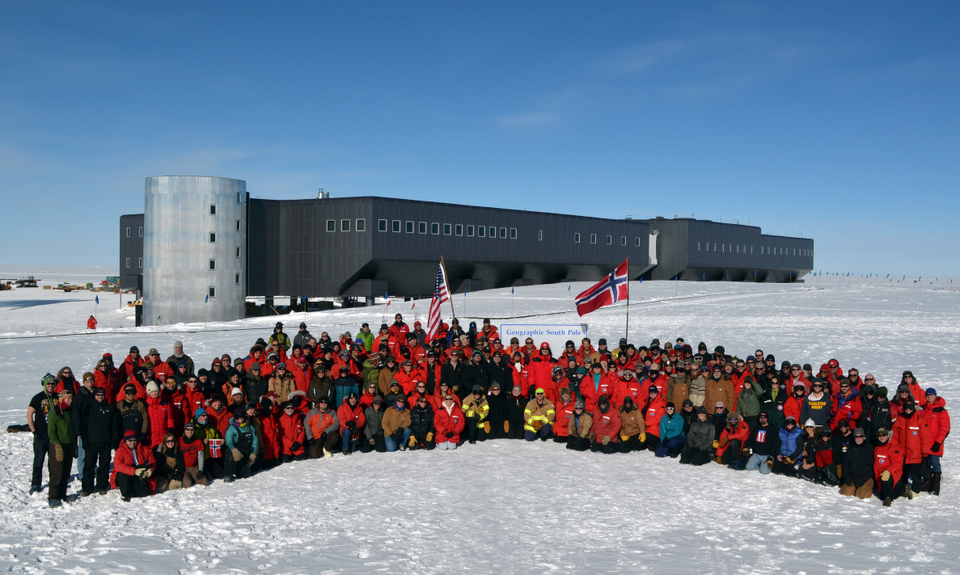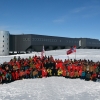CHAPTER 11
December 14th, 2011 marked the 100 year anniversary of Man first setting foot upon the Geographic South Pole of our planet. The story behind this remarkable achievement is long and engaging, an adventure fraught with peril and courage, deceit and honor, tragedy and triumph. The short version is that it basically all came down to a race between three men: Scott and Shackleton, both Englishmen, and Amundsen, a Norwegian.
Scott, with Shackleton serving under him, led an expedition to Antarctica in 1901. They spent more than two years conducting scientific research and exploration, but on their furthest adventure south, fell short of the Pole by a good 350 miles. Shackleton (slightly embittered by his subordinate position under Scott) returned at the command of his own expedition in 1909, this time coming within 100 miles of the Pole before having to turn back.
Though Scott was incredibly gracious, I can only imagine that he was clicking his heels at Shackleton’s failure, at least in his mind, and began in earnest making preparations for his next assault on the Pole. Meanwhile, apparently unbeknownst to Scott, the famous Norwegian polar explorer Roald Amundsen, who was the first to navigate the fabledNorthwest Passage, was making his own plans to be the first to the South Pole.
Amundsen has been painted in somewhat of a treacherous light by some historians, but others only laud his praises. I am not sure what to believe, having read a few differing accounts of Amundsen’s actions, but his devious reputation comes from the fact that during the whole of his planning phase, he made it known to everyone, including his government, his sponsors and his crew, that he was preparing an expedition to the North, but as soon as his ship left dock, he steered a southerly course and headed straight for Antarctica, with the singular goal of reaching the South Pole first.
Scott and Amundsen arrived in Antarcticaat about the same time, but not before ol’ Roald, perhaps to give Scott a fighting chance, sent his competitor a telegraph letting him know that the race was on. Scott used ponies and prototype motorized tractors to pull his sleds, while Amundsen went with the tried and true sled dogs, which ended up paying off… Amundsen reached the South Pole on December 14th, more than a month ahead of Scott. He left his tent, with a curt, but congenial note inside addressed to Scott requesting him to forward it on to the King of Norway on Scott’s return should Amundsen himself not survive, and then headed back to his ship, returned to Norway, and became an international hero. Scott, on the other hand, stoically wore the shoes of second place in true English fashion, retrieved Amundsen’s note, and trudged back the way he came. Tragically, he and his four companions died of starvation and exposure on the return journey when they got stuck in a white-out blizzard that lasted more than a week, sardonically only 11 miles from their next supply depot.
One hundred years later, and I can only imagine what Scott and Amundsen would have thought of the bustling science base that has sprung up on the location of their perilous goal. What was a life or death struggle for them to reach, is an easy walk for me- I don’t even have to wear a coat to get to the Pole if I move quickly. But ultimately, none of this would be here without both of their ambition, perseverance and fortitude. Sure, someone else would have made it eventually, but they were the first, and they are who we celebrate. Unfortunately for Scott, he took the place of the 2nd child to be born, a day late and a dollar short, thus Amundsen and Norway get most of the glory on this day. But Scott is still remembered, and honored, in the speeches given during the Centennial celebration, and more permanently as part of the namesake of the station.
To mark the centennial, there were quite a few special events planned here at the station. To start, the Prime Minister of Norway flew in with his entourage, he being only the second head of state to visit the South Pole ever. The whole station took to calling him “the Prime” for simplicity sake (but not to his face of course) and Kacey and I, in our lofty positions as stewards, had the privilege of preparing his room and making his bed. I know it’s not quite the same, but if I were Norwegian, this would have been like fluffing Obama’s pillow. He gave a “thanks for having me” speech to the entire station staff in the galley on the night of his arrival, and the next day we all went out and took a big group photo with him in front of the Geographic South Pole, followed by a cocktail party where his staff served traditional Norwegian holiday cookies that they had baked with the help of our chefs and a mulled wine called glögg, full of raisins and almond slivers. I’m not a huge fan of raisins, especially when they are floating like soggy dead bugs in my drink, but since the glögg was free, and a cultural experience to boot, I consented to having a few glasses.
The next day was the 14th, and the whole station was invited to attend a speech by the Prime out at the Pole, which was taped by a few journalists that had showed up for the ceremony and broadcast to the world. There followed a private banquette for all the Norwegians and a few of our upper management, but also one of our fellow stewards was invited to attend as an honored guest in recognition of a giant mural she had painted as a memorial to Amundsen.
The other big shake-up to our normal routine at the station was the arrival of over 100 tourists. Most flew in on old DC-3s, some drove in using absolutely tough looking trucks modified for the extreme cold and snow, and the rest, the most adventurous of the bunch, skied in, hauling sleds behind them with all their equipment, some as much as 200lbs. One grizzled old man went so far as to use Amundsen era equipment- long wooden skies, a wooden sled, fur boots and coat, and even an exact replica of Amundsen’s canvas tent. It was a bit surprising however, and more than a little surreal, to see him pull a satellite phone from his pocket and begin dialing some far away number with his old-school fur and leather mittens.
To accommodate this hoard of centennial interlopers, our heavy machine operators groomed a large camping area about a half a mile from the station, connected to the Pole by a plowed road, where the tourists and their tour companies set up a phalanx of ground tents, some latrines, and a long, modern, jamesway for communal cooking and hanging out. Being a tourist at the South Pole is a little different than anywhere else in the world. Basically the only thing that they are able to see here is the South Pole itself, which even if you stretch it out by taking a bunch of goofy pictures, can only occupy your time for ten or 15 minutes at most. They are allowed a brief tour of the main station, and if they are lucky given a cookie and a hot mug of tea, but other than that, they are strictly forbidden from entering any of the other science buildings, our jamesways, or even walking through the main area surrounding the station. I like them though, and always think it is pretty great seeing them wide-eyed and camera happy as they are slowly led from one end of the station to the other, but it can get pretty annoying and become a huge hassle if you are trying to mop the main hallway, as I often am. The reason for the cold shoulder shown to these tourists, who have paid so much and traveled so far to get here, is because USAP’s mandate at the Pole is to conduct and support scientific research, not to be in the business of hosting travelers (except for Kacey and me that is).
Considering it is the Centennial though, and that there are about ten times as many tourists as would show up during a normal year, the powers-that-be did make a concession towards commercialization of the South Pole by setting up a warm and toasty visitor center, complete with informative displays explaining the running of the station and the different science projects going on, and also a small gift shop right outside by the Pole. This seems a little tacky to me, the gift shop part, considering what a unique place this is. Can you imagine coming all the way here from China, as some of them do, just to buy an Antarctica t-shirt that was made in China? But at least they are not hawking some sort of staged photo with you holding the pole and an airbrushed penguin in the background, instantly printed and set in a cheap commemorative picture frame. It’s actually not as bad as I make it sound- I might just be bitter because, until all the tourists leave, the station staff isn’t allowed to buy any of the new Centennial merchandise.
Well, after the Prime Minister’s speech at the Pole, we decided to take a walk out to the tourist camp and have a look at their digs. On the way, one of the tour company trucks was about to overtake us on the road, so Kacey stuck out her thumb, and amazingly the guy pulled to a stop and let us climb in! I was so stoked to get a ride in one of these vehicles that had crossed the continent by land. It was basically just a normal Ford conversion van on the inside, but had been modified with duel axels in the back, a huge lift, and six beefy tires that had some sort of permanent bead so they could be run at extremely low pressures (4 to 6 psi) without fear of the tire popping off the rim. The necessity of such low tire pressure, as we had similarly learned driving through the desserts of South America, is to distribute the load of each tire over a greater area thus allowing them to easily drive across hundreds of miles of soft snow. On reaching the camp, we were dually invited into their main jamesway tent and given the tour. There wasn’t much to see, just a bunch of camp chairs situated around a few foldout tables, occupied by weary looking adventurers trying to warm up with mugs of coffee, some chatting, some playing cards, but most just looking glum. I don’t know if it was just because they were tired after the long flight, or even longer ski in, and now all the excitement of achieving the Pole was wearing off, or possibly they were feeling despondent after spending so much money on this three day adventure and now finding themselves in a cold, crowded, gloomy tent full of similarly dejected countenances with nothing to do. Either way it was a bit depressing, so we gave our thanks for the hospitality and adios’d as quickly as we had come in.
On our way back to the station, we decided that even though our current positions as stewards aren’t the most desirable one’s in the world, we are glad that we came down to the South Pole how we did: working a lot- yes, but at the same time being part of a vibrant and extraordinary community; not making much money, but not spending any either; and actually being able to experience life here at the Pole, rather than merely glimpsing it as part of a fleeting, and expensive, tour.
Prev ChapterNext Chapter


